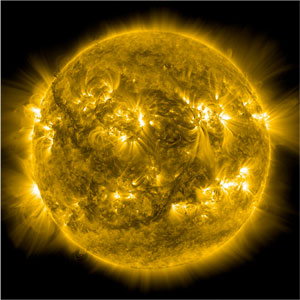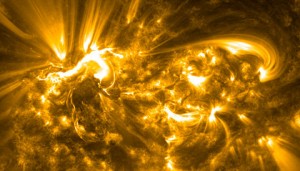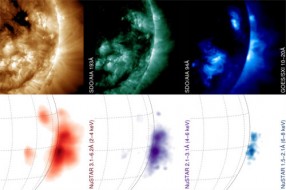New evidence suggests that nanoflares, small but potent bursts of energy, might heat the Sun’s atmosphere. But not everybody’s convinced.

NASA / AIA / SDO
For decades, scientists have struggled to understand why the Sun’s outer atmosphere, known as the corona, is a blistering-hot few million degrees when its visible “surface,” the photosphere, bubbles away miles below at only thousands of degrees.
But that isn’t to say scientists are at a loss for ideas. Perhaps, they’ve proposed, waves rippling along magnetic field lines carry energy onward and upward, ultimately dumping it into the corona. Or perhaps something stresses magnetic field lines until they snap, releasing tremendous amounts of power. That something could range from normal turbulence, magnetic tornadoes whipped up in the solar atmosphere, or even complicated “magnetic braid” structures. It’s even possible that all of these mechanisms, or still more not listed here, play some role in heating the corona.
To figure out how these mechanisms work, there’s another question to answer first: Is the heating process steady, or does it occur in explosive bursts known as nanoflares?
The idea of nanoflares dates back to 1964, but actually proving their existence is near impossible. By solar standards, nanoflares are small stuff — they release one-billionth the energy of regular flares.

NASA / SDO / AIA
“We haven’t been able to resolve an individual nanoflare,” said James Klimchuk (NASA Goddard) in a press conference at the Triennial Earth-Sun Summit in Indianapolis. “Even if we zoomed in on a small patch of the corona, we would still be looking at overlapping events.”
The events are simply so small, quick, and faint (compared with the larger flares that whip out from the Sun’s atmosphere) that even modern space telescopes can’t capture them individually (though they can come close).
Yet each nanoflare still unleashes the energy of a 50 megaton hydrogen bomb. Astronomers such as Klimchuk think there may be millions of these events occurring every second on the surface of the Sun, together releasing enough energy to heat the corona.
Extreme Ultraviolet Clues

U.S. Government
Now these astronomers have found strong indirect evidence that these small explosions are heating the solar corona. Adrian Daw (NASA Goddard) presented results from the Extreme Ultraviolet Normal Incidence Spectrograph (EUNIS) sounding rocket mission at the April 28th press conference that point to short-lived pockets of superhot plasma in the corona that, the researchers argue, could only come from nanoflare heating.
At about 10 million Kelvin, this plasma is ten times hotter than the already sizzling corona and represents the combined echo of many tiny flashes in the solar atmosphere, Daw says.
Launched in December 2013 on a sounding rocket, EUNIS was able to see the superhot plasma from a vantage point high above Earth’s atmosphere for only a few critical minutes — the rocket spent 15 minutes in flight, with 6 of those minutes dedicated to collecting data, and reached a peak altitude of 200 miles.
During those crucial 6 minutes, the instrument took a spectrum every 1.2 seconds. As a slit spectrograph and an imaging spectrometer, EUNIS was designed to measure spectral lines emitted at extreme ultraviolet wavelengths, between 52.5 and 63 nanometers. That allowed it to probe gas heated to between 25,000 and 10 million Kelvin.
Though these high temperatures appear to build a shoo-in case for nanoflares, high-energy X-ray observations from NASA’s NuSTAR spacecraft seem to say otherwise.

NASA / JPL-Caltech / GSFC
If nanoflares behave like mini versions of larger, well-observed flares, then the energy they unleash ought to accelerate particles and give rise to so-called “nonthermal” X-ray emission. Though NuSTAR sees thermal emission from the super-hot gas, it doesn’t find the expected accompanying nonthermal signature.
“Alas, I retain my skepticism here about nanoflares,” says Hugh Hudson, who is involved with NuSTAR’s solar observations. “The new evidence (especially EUNIS) is really interesting, but still not conclusive . . . The presence of 10 million Kelvin temperatures can be explained well enough by ‘flares,’ and so the need for a new physical mechanism (‘nanoflares’) seems like a stretch unless one has additional information.”
But NuSTAR’s lack of detection might be a matter of timing. The Sun is still active, so right now the telescope’s onboard computer can only process about 1% of the X-rays hitting the detectors, says David Smith (University of California, Santa Cruz). The bright, hot emission at lower X-ray energies overwhelms NuSTAR’s bandwidth. As solar activity decreases over the coming months and years, the efficiency should increase to 100%, giving NuSTAR a better shot at making out fainter, non-thermal emission — and perhaps providing definitive evidence in the case of nanoflares.
Read award-winning articles in Sky & Telescope's classic February 2011 issue on the Sun and learn how solar superstorms could affect Earth, plus learn how you can listen to and take pictures of our nearest star.
 0
0
Comments
You must be logged in to post a comment.